Mary Magdalene and Sacred Union
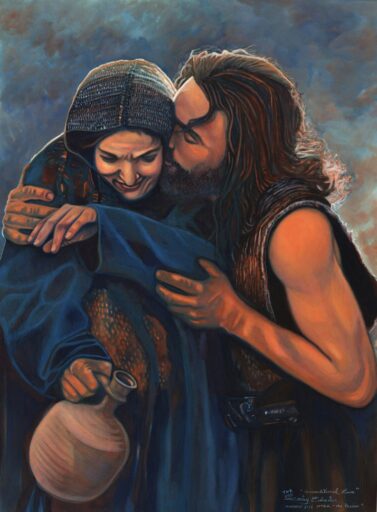
There is tantalising evidence that Mary Magdalene continued to offer the five sacraments of Jeseus, including performing baptisms, anointings (chrism), evangelising to help others to attain the restoration to fullness of being. (For more read my blog:’The Five Sacraments’).
Mary Magdalene reached the highest level of initiation and a ritual known as the Bridal Chamber with Jesus.
Like the Mystery Schools of the first century, Jesus offered an outer teaching and an inner teaching. Through this inner process the initiate realised their original state of tri-unity with God, perfected human and their divinity as fully realised humans, in Greek anthropos. (For more read my blog: ‘The Five Sacraments’)
The five sacraments were secret initiations and teachings Jesus had given his disciples called the five sacraments.
The fifth of the five sacraments was the Bridal Chamber. This remains shrouded in mystery and misunderstanding.
The Bridal Chamber is a metaphor for reunification, a merging and reuniting from separation to union. The ultimate goal is a spiritual union with God and the divine realm, escaping the constraints of the physical world.
The Bridal Chamber was an act of the deepest surrender, a sacred union of equals meeting in an intimate act of greatest vulnerability. “Sacred beings are entirely holy, including their bodies.” (‘Gospel of Philip’ analogue 60).
A couple who had completed all five sacraments would relate in relationship on a whole new level. This was not a marriage in the mundane sense but as a sacred, spiritual teaching tool.
This is exemplified by the sacred union of Jesus and Mary Magdalene.
The Bridal Chamber no doubt originated from the ancient sacred marriage rituals of Mesopotamia, Phoenicia, Canaan, Israel, Greece, and India. Known as Hieros Gamos, these rites were once performed annually by priestesses as the goddess and the reigning king as the god. Hieros means holy or sacred and gamos means marriage.
Sacred marriage was a potent and powerful spiritual path for the ancients, when Inanna and Dumuzi, Ishtar and Tammuz, Isis and Osiris, walked this path together. The rite was consummated in a sexual or symbolic union between a Sumerian king in the role of Dumuzi and a high priestess in the role of Inanna during the ceremony. (For more read my blog: ‘Before Spirituality Split from Sexuality’)

I have been married since 2001. I was 29. We are not the same people we were when we married. Or even ten years ago. We have journeyed through the highs and lows together.
The births of our three sons marked particularly tough milestones. Parenting is a crucible that brings up all your unprocessed childhood wounds. If you’re not careful you start playing out the unconscious patterns you witnessed and absorbed as a child. We have had to face ourselves and each other in the rawest, most uncomfortable places.
With each high and low our identities shifted and changed. We were called to honour each other in the good times and the bad, to see each other fully and to walk alongside them.
The kind of space where he could feel into the depths of his despair and anger, without me taking it personally. He can question his life without it meaning we fall apart.
Marriage is no picnic. The truth is when the going gets tough, most people bail. Just look at the divorce rates these days or the rise in polyamory. Most couples break when one of them evolves because it threatens the safety of the known.
There have been too many times when we weren’t sure we were going to make it. But time is measured differently in sacred union. Marriage is like a third organism separately to us individually. We allow our relationship to expand and contract, to breathe in and out. And so far we have been able to love each other through it all.
This is conscious love. Choosing each other every day. Not taking each other or our relationship for granted. Sacred union takes commitment.
If you ache for this kind of love, the kind that sees you, expands with you, and honours you…
It is possible. It is not easy.
It is a spiritual path.
What Is Sacred Union?
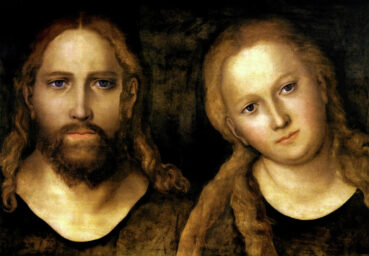
Sacred union means that you choose to love your partner. No matter what. Not trying to change them. Or fix them. Also not settling for poor behaviour or disrespect. It means you see the best in your partner invite them to aspire to be their best self. You respect and love each other and your relationship. You treat challenges as an opportunity for growth.
It means you stay. Even when it hurts. You sit in the unpleasant, downright uncomfortable painful times. You do not give up. Or run away. It means having the hard conversations.
This depiction of Jesus and Mary Magdalene was painted by Lucas Cranach in 1520, housed in Friedenstein Castle in Gotha, Germany.
Sacred union is about growing together, even when it terrifies you.
If you crave depth over variety, you long to build an eternal bond that sustains you through the mundane and the miraculous, you are on the spiritual path of sacred union.
But if we treat life like an adventure, we stay open and curious. We move through our relationship expecting change. And we find safety and security with a deep commitment that says we will be loved no matter what. We choose each other over and over again.
This is the kind of safety where we can express our sadness and rage without our partner taking it personally. It is the type of relationship where we can explore new versions of ourselves without fear of being too much or not enough.
Love that is truly sacred does not constrain up or keep you trapped in an old version of who you were. This kind of love wants you to be happy even if that means breaking up. This love invites you to explore the truth of who you are. And your partner chooses to celebrate each new version of you and choose to be by your side.
Sacred union is not for the faint hearted. It means we cannot run away when the going gets tough. We honour each other through the hard times, allowing each the space to change and grow.
The Indwelling of God

Sacred union goes beyond an external partner. It reminds us that when we come together in union both within and without, we heal a deep collective wound and “clothe ourselves in the light” of creation. This is a primordial reunion in the sacred marriage of the soul itself.
The Bridal Chamber was the reunification of the masculine and feminine aspects within us in a sacred union of equals to reach a higher state of perfection.
The bridal chamber signifies an internal unity of our masculine and feminine polarities within the heart of our spirit. This sacred union is experienced externally to balance and align these aspects within us. The initiate is no longer of the world but is reborn to their spirit, symbolised by the anointing in the Bridal Chamber.
‘Magdalene and Jesus – River Without End’ by Sue Ellen Parkinson.
In ‘Against Heresies’ Irenaeus, the Greek Bishop of Lygdunum (Lyon), said “Allow the seed of light to take up its abode in your bridal chamber. Receive your bridegroom from me and take him into you and be taken by him” (1:13:3).
Unity of being, the state of wholeness or oneness, is created within the Holy of Holies. Only then are we free to enter the Bridal Chamber. The Bridal Chamber does not confer a state of oneness. It is only the entry point for those who are already “clothed” (a recurring image in this text) to be admitted into its holiest inner sanctum to experience “the sacred embrace.”
Jesus diverged from Judaism with his affirmation of God’s immanence within all things and our ability to access it within ourselves (Luke 10:10-12, 17:21; John 5:37, 6:51, 6:54, 6:59-63, 10:34, 14:11, 10:30, 17:21-24).
This was also stated explicitly in the Dialogue of the Saviour: “For I [say] to you truly, the living God [dwells] in you [and you] in him.”
The phrase “make the two one” refers to the indwelling of God. The Kingdom was linked with self-knowledge that resulted in gnosis. This speaks of a oneness most people consider impossible on the Earth plane.
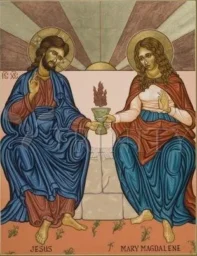
This is Jesus’ core teaching: “When you make the two one, and when you make the inside like the outside and the outside like the inside, and the above like the below, and when you make the male and the female one and the same, so that the male not be male nor the female female; and when you fashion eyes in the place of an eye, and a hand in place of a hand, and a foot in place of a foot, and a likeness in place of a likeness; then will you enter the kingdom.” (‘Gospel of Thomas’ Saying 22)
This boggles the mind, doesn’t it?
To be one with the living spirit we need to be childlike and to merge into oneness of Divine Union, where all separation dissolves. When this is achieved Jesus offers the ultimate goal. You become one not only within and with the living spirit, not only with all sentient beings even. You become one with the earth and its natural forces: Mother Nature.
Image is ‘Chalices of Mystery’ by Lewis Williams, 2009.
Jesus said: “When you make the two one, you will become the sons of man, and when you say, ‘Mountain, move away, it will move away’.” (‘Gospel of Thomas’ Saying 106)
The initiate would discover the truth of Jesus’ words for themselves: “…When you come to know yourselves, then you will become known, and you will realise that it is you who are the sons of the living father. But if you will not know yourselves, you dwell in poverty and it is you who are that poverty.” (‘Gospel of Thomas’ Saying 3)
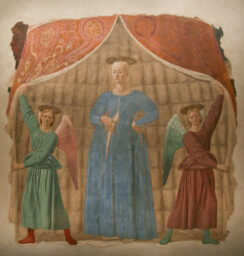 In ‘A Woman’s Spiritual Journey: Finding the feminine path to fulfilment’ Joan Borysenko states: “God is the Divine Beloved in every person. Making love to that Holy Being within a spouse or a lover, relating to the Divine in flesh, is a sacred act. We do this unconsciously in that first phase of a love relationship when we are infatuated with one another. The lover has no faults yet. They are perfect, and our physical love is guided by that perfection. So, sex is at its best. But later, when we realise our lover is human after all, we lose some of the passion and sweetness of the initial physical intimacy. To reclaim the ardour we once felt, we have to relate to the God within our lover.”
In ‘A Woman’s Spiritual Journey: Finding the feminine path to fulfilment’ Joan Borysenko states: “God is the Divine Beloved in every person. Making love to that Holy Being within a spouse or a lover, relating to the Divine in flesh, is a sacred act. We do this unconsciously in that first phase of a love relationship when we are infatuated with one another. The lover has no faults yet. They are perfect, and our physical love is guided by that perfection. So, sex is at its best. But later, when we realise our lover is human after all, we lose some of the passion and sweetness of the initial physical intimacy. To reclaim the ardour we once felt, we have to relate to the God within our lover.”
This fabulous fresco depicts a very clearly pregnant ‘Madonna del Parto’ by Piero della Francesca in around 1457. Here her dress has had to let out to make room her her growing bump!
For Gnostic initiates, the Bridal Chamber symbolises the reunification of the individual with their spiritual double and the divine, freeing them from the world of physical limitations and angelic influences to achieve a perfected state of being.
This process involves gaining gnosis (knowledge of the true self), uniting dualities like male and female, and escaping the material world to exist in a spiritual body of light.
In ‘Gnostic Secrets of the Naassenes: The Initiatory Teachings of the Last Supper’ Mark H. Gaffney explains that “The Gnostic interpretation of ‘one’ is the direct experience of the Godhead within, which resonates perfectly with the teaching of immanence. Gnostic Christians believed that it was for this that Jesus prayed in Gethsemane, and it was for this that Jesus made the ultimate sacrifice: to redeem the inner experience of God for humankind.”
The initiate can discover the truth of Jesus’ words: “…When you come to know yourselves, then you will become known, and you will realise that it is you who are the sons of the living father. But if you will not know yourselves, you dwell in poverty and it is you who are that poverty.” (Gospel of Thomas Saying 3)
From the Gnostic perspective it was up to each initiate to reach this state. It is their personal responsibility to raise themselves up to embrace the consciousness of the Pleroma (the fullness) and be reborn anew – resurrected. First the initiate needs to “flee the divisions and the fetters” of the material world to access a higher consciousness.
Jesus’ Companion
 Mary Magdalene was not just a follower of Jesus. She was a high initiate of his teachings. Mary Magdalene truly the “woman who knew the All” or who had understood completely. They explored the highest initiatory rites together, as equals. This was a relationship that transcended the normal bounds of teacher-student. They were lovers united by a common purpose.
Mary Magdalene was not just a follower of Jesus. She was a high initiate of his teachings. Mary Magdalene truly the “woman who knew the All” or who had understood completely. They explored the highest initiatory rites together, as equals. This was a relationship that transcended the normal bounds of teacher-student. They were lovers united by a common purpose.
The ‘Gospel of Philip’ depicts a level of intimacy between Jesus and Mary Magdalene that goes way beyond teacher disciple.
Mary Magdalene was his beloved companion: “[Jesus loved] her more than [all] the other disciples [and used to] kiss her [often] on her [mouth]” (63.34-65). The missing words missing from holes in the parchment have been inserted based on the grammar and context of the surrounding words. The tone is very notable, with the observation made as a complaint tinged with jealousy.
This image is a stain glass window in Kilmore Church, Isle of Hull.
The relationship between Jesus and Mary Magdalene is described as full of tenderness and affection. By demonstrating this to his disciples, Jesus gave an example of how relationships between people could be.
In the third century ‘Gospel of Philip’ and the mid-second century ‘Gospel of Thomas’ discovered at Nag Hammadi in 1945, Mary Magdalene is referred the koinonôs, meaning close companion or consort, of Jesus. The Greek word koinonôs has the explicit meaning of consort and refers to a wedded and intimate sexual partner. According to Jean-Yves Leloup in ‘Sacred Embrace of Jesus and Mary’, koinonôs means fiancé, spouse or companion, and signified a woman who was both wife and spiritual partner.
It would have also signified a recognised dynastic wife. The train of thought goes that Mary Magdalene was descended from King Saul of the tribe of Benjamin. Jesus, on the other hand, is descended from King David of the tribe of Judah. This makes their marriage a dynastic union reuniting two houses of Israel. This would explain why the apostles wanted to obscure the identity of Mary Magdalene and her relationship with Jesus.
Not just a follower, Mary Magdalene was Jesus’ equal.
The Way of Love
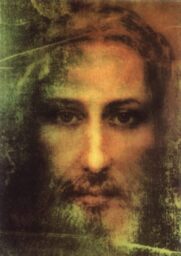 The Way of Love is a concept emphasising living a life of love, following Jesus’ teachings and example. This path represents a way of life that draws initiates closer to God and helps them experience and share his love with the world.
The Way of Love is a concept emphasising living a life of love, following Jesus’ teachings and example. This path represents a way of life that draws initiates closer to God and helps them experience and share his love with the world.
The Gnostic texts often depict dialogues between Jesus and his disciples. Jesus provides them with hidden wisdom, secrets, and esoteric knowledge as a way to escape the fallen, material body.
Jesus spoke in parables and allowed “whoever has ears, let them hear” (Matthew 13:9). The phrase is a call to be receptive to spiritual truths, to open one’s mind and heart to the teachings being shared, and to be willing to see and hear beyond the surface.
The ‘Gospel of Mary’ also uses similar language to highlight the importance of understanding and spiritual awareness “He who has ears to hear, let him hear” (4:24) and “He who has a mind to understand, let him understand” (4:29).
The image of Jesus is from the Turin Shroud.
This message was not understood purely by our intellect. This was the Way of Love, a path that was expressed through every word, thought and action. Jesus taught by example and so did Mary Magdalene. This is probably why we do not have great long lectures from either of them.
Jesus disrupted the narrative proposed by the beliefs, customs and culture of his day. He rejected and argued with the Jerusalem Temple and was quick to argue with his disciples when he saw any misogynistic narrative entering their attitudes, targeting Mary Magdalene.
Jesus wanted to balance the sexes, create greater rights for women and to open the door to spiritual enlightenment for men, women and children to enter. Rather than bar the door, Jesus sought to give everyone access.
Jesus’ Equal

Jesus did not do this work single handed. He had an equally wise and gifted partner who worked alongside him and acted as a role model for this new way of being in a sacred marriage of equals.
Jesus’ teaching was not a way of living but a way of being rooted in love in action. This can’t be taught or understood as a rational concept. Only Mary Magdalene knew because only she had been offered the direct transmissions and had the wisdom to understand. This was not separate to the spiritual teachings of Jesus. It was a very intimate sacred act of unifying with everything, honouring everything that brings about the magnetic.
In the ‘Pistis Sophia’ describes Jesus answering Mary Magdalene (called Miriam in this text): ‘Miriam, thou blessed one, whom I will complete in all the mysteries of height, speak openly, thou art she whose heart is more directed to the Kingdom of Heaven than all thy brothers.”
This image of Mary Magdalene and Jesus is by Lars Doerwald.
Jesus and Mary Magdalene shared a great love, a deeply real and intimate connection that transcended death itself. This great love has reverberated through the ages and continues to impact and influence us now. I believe sacred union not as a lofty ideal but as a lived experience was integral to Jesus’ teachings.
This is the divine feminine and divine masculine united in sacred union. The unification of the soul with the physical, mental and emotional body through the intelligence centre of the heart. This was the same path of gnosis that John the Baptist, Jesus, Mary Magdalene, the Buddha and many of the others have walked.
Jesus and Mary Magdalene represented the highest potential of a man and woman in sacred union. This was inner work that created an equal partnership.
In ‘The Sacred Embrace of Jesus and Mary: The Sex Mystery of the Heart of the Christian Tradition’ Jean-Yves Leloup describes this form of love making as “an act of the divine-as-human, or anthropos”.
But it is not just about an external partner. It goes so much deeper. It reminds us that when we come together in union both within and without, we heal a deep collective wound and clothe ourselves in the light of creation. This is a primordial reunion in the sacred union of the soul itself.
We are being asked to balance the masculine and feminine within in sacred union. This call has become more insistent in recent years. But first many of us needed to be more comfortable with our feminine before we could even begin to contemplate working with the masculine.
Jesus and Mary Magdalene followed a path of conscious love and sacred sexuality. I believe sacred union not as a lofty ideal but as a lived experience was integral to Jesus’ teachings. Jesus and Mary Magdalene shared a great love, a deeply real and intimate connection that transcended death itself.
This great love has reverberated through the ages and continues to impact and influence us now. This was a sacred union, a marriage of equals that helped them to evolve into completely realised humans, anthropos.
Jesus and Mary Magdalene demonstrated through his example what was possible through gnosis. He was the prototype of a spiritually perfected person; both human and divine.
What Mary Magdalene Teaches Us
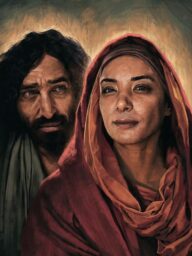
Mary Magdalene is a guide into sacred union. She is clearly on the spectrum of experience that delves deeply into the connection between spirituality and sex. Mary Magdalene invites us to explore all of our collective taboos around sex and the customs, culture and beliefs we have absorbed from Western society.
Mary Magdalene embodied sacred sexuality, divine wisdom, and feminine gnosis. Mary Magdalene invites us to draw more love into our bodies, into our relationships and our lives through our sexuality.
This begins by clearing and healing all the blocks and barriers residing in our pelvis. Mary Magdalene illuminates a new radical path that no longer condones the split between spirituality and sex.
This is my favourite depiction of Jesus and Mary Magdalene by Dietmar Pieper.
In ‘A Woman’s Spiritual Journey’ Joan Borysenko states: “Before we can think of sex as an act of deep communion with God, it has to be reclaimed from the sterile desert of puritanical religion. This may require healing if our religion has taught us that sex is dirty and ungodly, a nasty necessity for procreation in those without the commitment to lead a celibate, religious life.”
Sacred union is integral to our explorations of embodied feminine spirituality. Sacred union is a reunion of our energy. Sacred union is an expression of love that transcends the small self and enters communion with oneness.
Sacred union asks for us to heal the unmet or abandoned parts of ourselves. Only when we are aligned with our body, mind, emotions and spirit can we tune in and reconnect with the truth of who we are – the eternal soul self that resides within us all. It also means tapping into the vast support system that is always there, just waiting to be accessed.
In ‘Bringers of the Dawn: Teachings of the Pleiadians’ Barbara Marciniak encourages us to examine our sexual history as it “affects every other portion of your soul, so all of your soul’s issues are broadcast loud and clear throughout your body”. Marciniak explains that sexuality is a frequency that “represents what was not taken away from you even though your history, your memories, and your identity were removed and scattered. The way you were left intact with the ability to discover who you were was through the sexual experience”.
Marciniak admits that can be excruciatingly painful to explore, and to stop judging it as bad, and instead come to a place where we feel “neutral about what you have done-no matter what you discover, no matter how heinous it seems, no matter how difficult it seems, and no matter how much violation it involves. Understand that your purpose has been to gather data and to understand yourselves”.
Sacred union calls for an opening of our sacred heart, expanding our capacity to love and be loved. It involves the complete transformation of our sexuality not through repression or indulgence, but through raw vulnerability, tenderness and acceptance on every level, layer and dimension of the beloved. Sacred union allows complete vulnerability and freedom to be an embodiment of joyful, loving presence. Sacred union is a deep spiritual practice.

What we seek is harmony and honouring the healthy aspects of both spirituality and sexuality to merge our masculine and feminine aspects on every level, layer and dimension of our being.
This merging of our masculine and feminine is at the heart of every mystery teaching of the religions of the world. Sacred union is not for the faint hearted. Choosing a sacred union of equals is daunting and absolutely will bring out the unworthiness in most people!
Sacred union requires an absolute commitment to release of every trauma, every disappointment, every heartbreak as well as the healing of every fear, neurosis, hateful feeling, self-sabotaging and self-protective mechanism.
When we enter into sex as a sacred union, our partner feels it immediately when our thoughts are elsewhere. To give ourselves fully to this now moment, to make love to another human being can give us the ultimate experience of oneness while still in the human body.
Mary Magdalene gives us a transmission of her essence, an experiential direct experience that goes beyond anything we can read, any concept or theory you can access. We have to feel it ourselves. We cannot just read a book about this.
Mary Magdalene is all about embodiment, feeling safe and home inside our body. This is the missing piece of the puzzle I had been searching for.
Like my vision of her way back in 2018, Mary Magdalene will not tell us what to do. She will merely point the way, inviting us to discover what our own unique path is for ourselves.
This mixed media work called ‘Magdalena’ is by Lisbeth Cheever-Gessaman (She who Is).
Mary Magdalene helps us to remember.
Everything we need is within.
Mary Magdalene was most likely an ordained priestess, a prophetess, a mystic a powerful preacher and an initiator who performed baptisms. Mary Magdalene continued her own ministry after the crucifixion who preached Jesus’ message in Gaul (France) and Spain.
Feature Image: ‘Unconditional Love Mary and Jesus’ by Corby Eisbacher.
